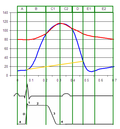Ventricle (heart)
Ventricle (heart)[edit]
The ventricles are the two lower chambers of the heart in vertebrates. They are responsible for pumping blood out of the heart to the lungs and the rest of the body. The heart has two ventricles: the right ventricle and the left ventricle.
Structure[edit]
The ventricles are located in the lower part of the heart, beneath the atria. The right ventricle receives deoxygenated blood from the right atrium and pumps it into the pulmonary artery towards the lungs. The left ventricle receives oxygenated blood from the left atrium and pumps it into the aorta to be distributed throughout the body.
The walls of the ventricles are thicker than those of the atria, with the left ventricle having the thickest wall due to the higher pressure required to pump blood through the systemic circulation.
Function[edit]
The primary function of the ventricles is to pump blood. The right ventricle pumps blood to the lungs for oxygenation, while the left ventricle pumps oxygenated blood to the rest of the body. This process is part of the cardiac cycle, which includes the phases of systole and diastole.
Clinical significance[edit]
Ventricular function is crucial for maintaining adequate cardiac output. Conditions such as ventricular hypertrophy, ventricular fibrillation, and heart failure can significantly impact the function of the ventricles and overall heart health.
Images[edit]




Related pages[edit]
♥
-
Internal structure of the heart
-
Wiggers Diagram
-
Wiggers Diagram
Ad. Transform your life with W8MD's Budget GLP-1 injections from $75


W8MD offers a medical weight loss program to lose weight in Philadelphia. Our physician-supervised medical weight loss provides:
- Weight loss injections in NYC (generic and brand names):
- Zepbound / Mounjaro, Wegovy / Ozempic, Saxenda
- Most insurances accepted or discounted self-pay rates. We will obtain insurance prior authorizations if needed.
- Generic GLP1 weight loss injections from $75 for the starting dose.
- Also offer prescription weight loss medications including Phentermine, Qsymia, Diethylpropion, Contrave etc.
NYC weight loss doctor appointmentsNYC weight loss doctor appointments
Start your NYC weight loss journey today at our NYC medical weight loss and Philadelphia medical weight loss clinics.
- Call 718-946-5500 to lose weight in NYC or for medical weight loss in Philadelphia 215-676-2334.
- Tags:NYC medical weight loss, Philadelphia lose weight Zepbound NYC, Budget GLP1 weight loss injections, Wegovy Philadelphia, Wegovy NYC, Philadelphia medical weight loss, Brookly weight loss and Wegovy NYC
|
WikiMD's Wellness Encyclopedia |
| Let Food Be Thy Medicine Medicine Thy Food - Hippocrates |
Medical Disclaimer: WikiMD is not a substitute for professional medical advice. The information on WikiMD is provided as an information resource only, may be incorrect, outdated or misleading, and is not to be used or relied on for any diagnostic or treatment purposes. Please consult your health care provider before making any healthcare decisions or for guidance about a specific medical condition. WikiMD expressly disclaims responsibility, and shall have no liability, for any damages, loss, injury, or liability whatsoever suffered as a result of your reliance on the information contained in this site. By visiting this site you agree to the foregoing terms and conditions, which may from time to time be changed or supplemented by WikiMD. If you do not agree to the foregoing terms and conditions, you should not enter or use this site. See full disclaimer.
Credits:Most images are courtesy of Wikimedia commons, and templates, categories Wikipedia, licensed under CC BY SA or similar.
Translate this page: - East Asian
中文,
日本,
한국어,
South Asian
हिन्दी,
தமிழ்,
తెలుగు,
Urdu,
ಕನ್ನಡ,
Southeast Asian
Indonesian,
Vietnamese,
Thai,
မြန်မာဘာသာ,
বাংলা
European
español,
Deutsch,
français,
Greek,
português do Brasil,
polski,
română,
русский,
Nederlands,
norsk,
svenska,
suomi,
Italian
Middle Eastern & African
عربى,
Turkish,
Persian,
Hebrew,
Afrikaans,
isiZulu,
Kiswahili,
Other
Bulgarian,
Hungarian,
Czech,
Swedish,
മലയാളം,
मराठी,
ਪੰਜਾਬੀ,
ગુજરાતી,
Portuguese,
Ukrainian


